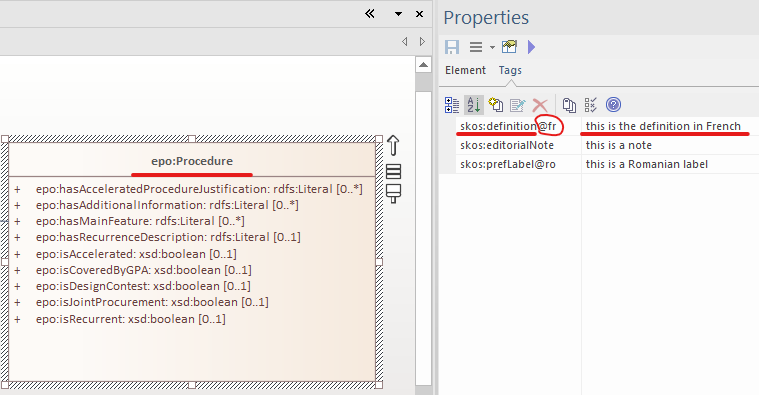Transformation of UML descriptors and tags
In this section are specified transformation rules for UML descriptive elements. Table 1 provides an overview of the section coverage.
| UML element | Rules in core ontology layer | Rules in data shape layer | Rules in reasoning layer |
|---|---|---|---|
Name |
|||
Note |
|||
Comment |
|||
Tag |
|||
Source |
Name
Most of the UML elements are named. The UML conventions dedicate an extensive section to the naming conventions and how to deterministically generate a URI and a label from the UML element name. By default, we recommend the use of the SKOS lexicalization (skos:prefLabel) in the core ontology layer. In the future, this could be controlled by a flag in the configuration of the transformation tool. With such a flag one could enable RDFS lexicalization (rdfs:label) instead of, or in addition to, the SKOS lexicalization.
Specify a label for the OWL entity based on the name of the UML element.
Listing 1. Labels in Turtle syntax
|
Listing 2. Labels in RDF/XML syntax
|
Specify a label for the SHACL shape, based on the name of the UML element.
Listing 3. Label declaration for NodeShape in Turtle syntax
|
Listing 4. Label declaration for NodeShape in RDF/XML syntax
|
Listing 5. Label declaration for PropertyShape in Turtle syntax
|
Listing 6. Label declaration for PropertyShape in RDF/XML syntax
|
Note
Most of the UML element foresee provisions of descriptions and notes. They should be transformed into rdfs:comment and skos:definition.
By default, we recommend the use of the SKOS lexicalization (skos:definition) in the core ontology layer. In the future this could be controlled by a flag in the configuration of the transformation tool. With such a flag one could enable RDFS lexicalization (rdfs:comment) instead of, or in addition to, the SKOS lexicalization.
Specify a description for the OWL entity based on the note on the UML element.
Listing 7. Description in Turtle syntax
|
Listing 8. Description in RDF/XML syntax
|
Specify an annotation (comment or description) for the SHACL shape based on the note on the UML element.
Listing 9. Note declaration for NodeShape in Turtle syntax
|
Listing 10. Note declaration for NodeShape in RDF/XML syntax
|
Listing 11. Note declaration for PropertyShape in Turtle syntax
|
Listing 12. Note declaration for PropertyShape in RDF/XML syntax
|
Comment
In accordance with [uml2.5], every kind of UML Element may own Comments (see Figure 1). They add no semantics but may represent information useful to the reader. In OWL it is possible to define the annotation axiom for OWL Class, Datatype, ObjectProperty, DataProperty, AnnotationProperty and NamedIndividual. The textual explanation added to UML Class is identified as useful for conceptual modelling , therefore the Comments that are connected to UML Classes are taken into consideration in the transformation.

As UML Comments add no semantics, they are not used in any method of semantic validation. In OWL the AnnotationAssertion axiom [owl2] does not add any semantics either, and it only improves readability.
By default, we recommend the use of the SKOS lexicalization (skos:editorialNote) in the core ontology layer. In the future this could be controlled by a flag in the configuration of the transformation tool. With such a flag one could enable RDFS lexicalization (rdfs:comment) instead of, or in addition to, the SKOS lexicalization.
Specify an annotation axiom (comment or editorial note) on the OWL entity for the UML Comment associated to a UML element.
Listing 13. Comment in Turtle syntax
|
Listing 14. Comment in RDF/XML syntax
|
Specify an annotation axiom (comment or description) on the SHACL shape for the UML Comment associated to a UML element.
Listing 15. Note declaration for NodeShape in Turtle syntax
|
Listing 16. Note declaration for NodeShape in RDF/XML syntax
|
Listing 17. Note declaration for PropertyShape in Turtle syntax
|
Listing 18. Note declaration for PropertyShape in RDF/XML syntax
|
Tags
Any UML element can have additional information provided by means of tags, represented by UML Tag elements. Such tags should be transformed into annotation on the RDF resource representing the UML element (e.g. Class, Attribute, Connector). The language tags that are provided on the tag, can be used to generate multilingual ontologies/specifications. For example, the highlighted elements in Figure 2 would be transformed in the following Turtle statement epo:Procedure skos:definition "this is the definition in French"@fr .

| The generation of annotations from tags could be controlled by a flag in the configuration of the transformation tool. |
Specify an annotation axiom on the OWL entity for each UML Tag associated to a UML element. If a tag has an associated language tag, it should be attached to the value.
Listing 19. Tags in Turtle syntax
|
Listing 20. Tags in RDF/XML syntax
|
Source
It is a good practice to annotate all concepts in an ontology with the IRI of the ontology where these concepts are defined. RDFS provides a dedicated property for purpose, called rdfs:isDefinedBy, which we will use.
Annotate all locally defined OWL concepts with the name of the (core) ontology that defines them.
Listing 21. Source in Turtle syntax
|
Listing 22. Source in RDF/XML syntax
|
For all SHACL shapes specify the source ontology defining the shape.
Listing 23. Source declaration for NodeShape in Turtle syntax
|
Listing 24. Source declaration for NodeShape in RDF/XML syntax
|
Listing 25. Source declaration for PropertyShape in Turtle syntax
|
Listing 26. Source declaration for PropertyShape in RDF/XML syntax
|